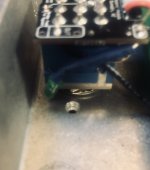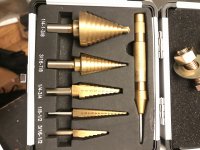Two things that have done me well. Life is very simple with a drill press.
Center punch of any sort that you can impact a dent into the taped on drill guide. No brainer here. Manual, spring loaded, whatever you choose, it is the best way to translate the drill guide to the enclosure. Just make sure you get this part accurate because everything downstream is dependent. Easy stuff, just take your time.
Chuck up a 1/16th or so drill bit and let it drop into those dents. You really can use the finished hole size bit here but to be honest it's easier to let the drill press "find" the dent with a skinny drill bit. It's a feel thing and you'll use a light touch to let the bit center itself.
Once those holes are done it's just a matter of chucking up the right size bit and literally "dropping" it into the hole you've made.
Set your drill press to be relatively slow. This is counter intuitive after using a hand drill. I have my cheap Ryobi set to 570 RPM's. This means that you have to have a light touch with the pressure on the bit. Don't rush it, get a feel for how the material is reacting to the drill. You don't want it to grab the piece.
Most importantly revel in the fact that this is likely the most accurate way to drill an enclosure. After a few drills you'll get used to how much pressure you can get away with and you'll be rewarded with nice consistent holes.


